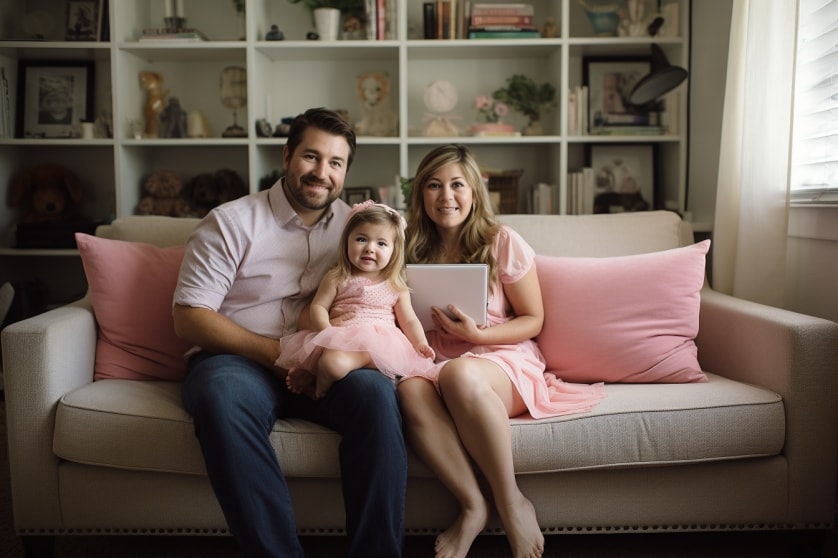Table of Contents
ToggleThe Real Cost of Raising a Baby: A Guide for New Parents
It’s no secret that having a baby can be expensive, but just how expensive? The truth is, the cost of raising a child from birth to age 18 can easily reach hundreds of thousands of dollars. That’s a daunting number for any new parent to face, especially when they’re already juggling the demands of a newborn.
But here’s the good news: by understanding the real cost of raising a baby and taking steps to prepare financially, new parents can feel more confident and empowered in their role as caregivers.
So, let’s dive into the nitty-gritty of baby budgeting, shall we?
- First, let’s talk about creating a budget. From hospital bills to diapers, the costs of having a baby can quickly add up. By creating a budget and tracking expenses, new parents can gain a clearer understanding of where their money is going and make adjustments as needed.
- Next, let’s look at healthcare costs. Prenatal care, delivery fees, and postpartum care can all be significant expenses, so it’s important to understand how insurance works and how to choose the best plan for your family’s needs.
- Of course, no baby budget would be complete without considering the cost of baby gear. From cribs to car seats, it can be overwhelming to choose the right products for your little one. But fear not – we’ve got tips for finding quality gear on a budget.
- Then, there’s the matter of childcare. Whether you’re considering daycare, hiring a nanny, or staying at home with your baby, there are financial implications to each choice. We’ll break down the pros and cons of each option and offer money-saving tips.
- Finally, we’ll tackle the long-term costs of raising a child, including education and extracurricular activities. By planning ahead and making smart financial decisions, new parents can set their child up for success without breaking the bank.
So, new parents, take a deep breath and know that you’re not alone in navigating the financial challenges of raising a baby. With some research, planning, and smart budgeting, you can provide your little one with the love, care, and financial stability they need to thrive.

Creating a Budget
Let’s face it, babies are expensive. And unless you’re Beyoncé or Jeff Bezos, you’re going to need to create a budget to make sure you’re not breaking the bank every time you walk down the baby aisle at Target.
First things first, it’s important to determine your current expenses and income. Take a look at your bank statements and figure out how much money you’re bringing in each month and how much you’re spending on rent, groceries, utilities, entertainment, and so on. This will give you a good idea of how much wiggle room you have in your budget for baby-related expenses.
Next, you’ll want to estimate the cost of baby essentials, such as diapers, wipes, formula (if you’re not breastfeeding), and clothing. According to BabyCenter, the average family spends around $12,000 in the first year of their baby’s life, and that doesn’t even include big-ticket items like a crib, stroller, or car seat.
Speaking of big-ticket items, it’s important to prioritize your baby gear needs. You might feel tempted to buy every cute onesie and baby gadget you come across, but the truth is, not everything is essential. Take some time to research the must-have items and invest in quality products that will last, rather than cheaping out on items that will need to be replaced in a few months.
Once you have a rough estimate of your baby-related expenses, it’s time to create a budget. You can use a spreadsheet or a budgeting app to help you keep track of your income and expenses. Make sure to include a category for baby-related expenses and track your spending to make sure you’re staying within your budget.
It’s also important to remember that unexpected expenses can pop up at any time. For example, your baby might have a sudden medical issue or you might need to purchase a new car to accommodate your growing family. Make sure to build an emergency fund into your budget to cover these unexpected costs.
Finally, don’t be afraid to get creative when it comes to saving money on baby expenses. You can buy gently used baby gear from consignment shops or online marketplaces like Facebook Marketplace or Craigslist. You can also sign up for free samples and discounts from baby companies or take advantage of coupon codes and sales.
Creating a budget might not be the most glamorous part of parenthood, but it’s an essential step in ensuring that you can provide for your baby without sacrificing your financial stability. By taking the time to create a budget and track your spending, you’ll be able to enjoy all the joys of parenthood without the added stress of financial worries.

Healthcare Costs
When it comes to your baby’s health, you want the best of the best. But unfortunately, healthcare costs can add up quickly, especially if your baby has any medical issues.
First and foremost, you’ll want to make sure you have adequate health insurance coverage for your baby. Depending on your insurance plan, you may need to add your baby to your policy within a certain timeframe after their birth. Make sure to review your insurance policy and speak with a representative to understand your coverage and any out-of-pocket costs you may be responsible for.
Even with insurance, you may still be responsible for copays, deductibles, and other out-of-pocket expenses. It’s important to budget for these costs and plan accordingly. You may also want to consider opening a health savings account (HSA) or flexible spending account (FSA) to help offset some of these costs.
In addition to routine healthcare expenses like well-baby checkups and vaccinations, you’ll also want to budget for unexpected medical issues. Unfortunately, babies can get sick or injured at any time, so it’s important to have an emergency fund set aside to cover these costs.
It’s also worth noting that some medical expenses may not be covered by insurance, such as certain therapies or treatments. In these cases, you may want to look into alternative options, such as community clinics or crowdfunding platforms.
Another factor to consider when it comes to healthcare costs is childcare. If you’re returning to work after having a baby, you’ll need to budget for childcare expenses, which can be a significant cost. Depending on where you live and your specific childcare needs, you could be looking at thousands of dollars per year in childcare costs.
Finally, don’t forget about your own healthcare costs as a new parent. Giving birth and recovering from childbirth can be a major expense, and you’ll also want to make sure you’re taking care of your own health and wellbeing as you adjust to parenthood.
Overall, healthcare costs are an important consideration when it comes to the real cost of raising a baby. By understanding your insurance coverage, budgeting for routine and unexpected expenses, and exploring alternative options, you can help ensure that your baby stays healthy without breaking the bank.

Baby Gear
One of the most exciting parts of preparing for a new baby is shopping for all of the cute and cuddly baby gear. But with so many products on the market, it can be overwhelming to know what you actually need and what’s just a nice-to-have.
First and foremost, you’ll need a safe place for your baby to sleep. This could be a crib, bassinet, or co-sleeper, depending on your preference and space constraints. Keep in mind that many parents opt for a bassinet or co-sleeper for the first few months, as it allows for easy nighttime feedings and close proximity to your baby.
In addition to a place to sleep, you’ll also need a car seat. This is one item that you absolutely cannot skimp on, as it’s essential for keeping your baby safe while traveling. Make sure to research car seat safety ratings and choose a model that fits your car and meets all safety standards.
Another essential piece of baby gear is a stroller. This can be a major expense, with some high-end models costing upwards of $1,000. But keep in mind that a basic, affordable stroller can still get the job done just fine. Consider your lifestyle and needs when choosing a stroller – do you need something lightweight and compact for city living, or a heavy-duty jogger for off-road adventures?
Other items to consider when it comes to baby gear include a baby carrier or wrap (great for hands-free snuggles), a diaper bag (look for one with plenty of pockets and compartments), a high chair or booster seat (when your baby is ready for solids), and a baby monitor (so you can keep an eye on your little one while they sleep).
It’s worth noting that while it can be tempting to buy every baby product under the sun, many items are unnecessary and can quickly add up in cost. For example, a wipe warmer or bottle sterilizer may seem like a great idea, but in reality, they’re not essential and can take up valuable space in your home.
To save money on baby gear, consider buying secondhand or borrowing from friends and family. Many baby items are only used for a short period of time, so you can often find gently-used items for a fraction of the cost. You can also look for deals and discounts at retailers or online marketplaces.
Overall, while baby gear can be a significant expense, it’s important to focus on the essentials and avoid getting caught up in the latest trends or gimmicks. By investing in quality, safe items and being smart about your purchases, you can provide for your baby without breaking the bank.

Childcare
Childcare is a significant expense for many new parents. Whether you plan to go back to work full-time, part-time or just need occasional help, you need to factor in the cost of childcare in your budget. Here are some tips to help you save money on childcare:
1. Explore your options
When it comes to childcare, you have several options to choose from. You can choose a daycare center, hire a nanny, or ask a family member to help out. Each option has its advantages and disadvantages, so it’s important to research and compare your options to find what works best for your family and budget.
2. Consider sharing a nanny or babysitter with another family
If you have a friend or neighbor with a child around the same age as yours, consider sharing a nanny or babysitter. This can cut your childcare costs in half, and your child can have a playmate.
3. Look for discounts and subsidies
Some employers offer discounted childcare services as a perk to their employees. Look into your company’s benefits to see if this is an option for you. Additionally, some states offer subsidies for low-income families to help with childcare costs. Check with your local government to see if you qualify.
4. Be flexible
If you have a flexible work schedule, you may be able to work from home some days or adjust your hours to cut down on childcare costs. Alternatively, you can consider a nanny share with another family or a daycare center that offers part-time or drop-in care.
5. Plan ahead
When you are expecting a child, start thinking about your childcare options and budgeting for the costs. Research your options, and don’t be afraid to negotiate prices. If you plan ahead, you may be able to find a solution that works for your family and budget.
Remember, childcare costs can vary greatly depending on where you live and the type of care you choose. It’s essential to do your research, plan ahead, and be flexible to find a solution that works for your family’s needs and budget.

Long-term Costs
Raising a child involves long-term costs that can be a major financial burden for new parents. It’s important to consider these costs early on and start planning for them as soon as possible.
Education
One of the biggest long-term costs of raising a child is education. As your child grows older, they will need to attend school, and eventually, college. Private school tuition and college tuition can be very expensive, and the cost is only increasing. According to the College Board, the average cost of tuition and fees for the 2020-2021 school year was $37,650 at private colleges, $10,560 for in-state residents at public colleges, and $27,020 for out-of-state residents attending public colleges. That’s a lot of money!
There are several ways to save for your child’s education, including a 529 college savings plan, which allows you to save money tax-free for college expenses. Additionally, some states offer tax deductions or credits for contributions made to a 529 plan. Other options include Coverdell Education Savings Accounts (ESA) and custodial accounts (UTMA or UGMA). Talk to a financial advisor about the best options for your family.
Retirement
Another long-term cost to consider is retirement. While retirement may seem like a long way off, it’s important to start saving as early as possible to ensure a comfortable retirement. With the cost of living increasing every year, it’s important to save enough money to support yourself in retirement.
If you’re a working parent, consider contributing to a 401(k) or other retirement plan through your employer. Many employers offer a matching contribution, which is essentially free money towards your retirement savings. If your employer does not offer a retirement plan, consider opening an Individual Retirement Account (IRA) or Roth IRA. Again, talk to a financial advisor to determine the best options for your family’s financial situation.
Life Insurance
Finally, it’s important to consider life insurance as a long-term cost. While nobody wants to think about the worst-case scenario, it’s important to plan for it. If something were to happen to you or your partner, you want to ensure that your child is taken care of financially. Life insurance can provide that peace of mind.
Talk to a financial advisor to determine the appropriate amount of life insurance for your family’s needs. The amount will depend on several factors, including your income, debt, and future expenses (such as education).
Conclusion
Raising a child involves significant long-term costs, including education, retirement, and life insurance. It’s important to start planning for these costs early on and to consider all of your options. Talk to a financial advisor to determine the best ways to save for your child’s future and to ensure your family’s financial security.
Conclusion:
Congratulations, you have made it to the end of our guide to the real cost of raising a baby! By now, you should have a better understanding of the various expenses that come with having a little one and the steps you can take to plan for them.
Remember, raising a baby is an incredible experience that brings with it a lot of joy and fulfillment. However, it’s also a huge responsibility, and it’s important to take the financial aspect seriously so you can provide your child with the best possible future.
Here are a few key takeaways from our guide:
- Creating a budget is crucial to managing your finances and ensuring you’re prepared for the expenses of raising a baby.
- Healthcare costs can be a major expense, so be sure to research your options and take advantage of any available resources.
- Baby gear can quickly add up, but there are ways to save money without sacrificing quality.
- Childcare costs can vary greatly depending on your needs, so it’s important to do your research and consider all your options.
- Long-term costs, such as education and savings for the future, are important to plan for early on.
Ultimately, raising a baby is a unique and rewarding journey, and every family’s experience will be different. By taking the time to plan and budget for the various expenses that come with this new chapter in your life, you can feel confident and prepared to give your child the best possible start.
Best of luck to you and your growing family!
Want to take your knowledge to the next level? Check out these must-read articles:
- Maximizing Your Parental Leave: A Guide to Money Management
- How to Manage Your Finances with a New Baby: Tips for Success
Organize your baby’s wardrobe with our baby clothes closet organizer products! Our organizers are designed specifically for baby clothes. Get your baby’s clothes neat and tidy with our selection of organizers – shop now!
Hey there, are you craving a fresh perspective? Look no further! Feast your eyes on the awesome video below:
Beyond her professional achievements, Jessica is also a successful mother to a large and thriving family. Her firsthand experience in balancing financial responsibilities while raising multiple children gives her a unique perspective that resonates with her audience. As a mother, Jessica understands the financial challenges and pressures faced by families, and she brings a compassionate and relatable approach to her blogging. Through her blog, Jessica not only shares her financial expertise but also provides invaluable insights on how to foster financial well-being while building a strong and harmonious family foundation. Whether it's budgeting, saving for college, or teaching children about money, Jessica's relatable stories and practical tips make her an indispensable guide for individuals striving to achieve financial stability while nurturing a fulfilling family life.
- The Smart Parent’s Guide to Budgeting with a New Baby - September 12, 2023
- Preparing for the Unexpected Costs of Parenthood - September 11, 2023
- How to Find Affordable Health Insurance for Your Growing Family - September 10, 2023



